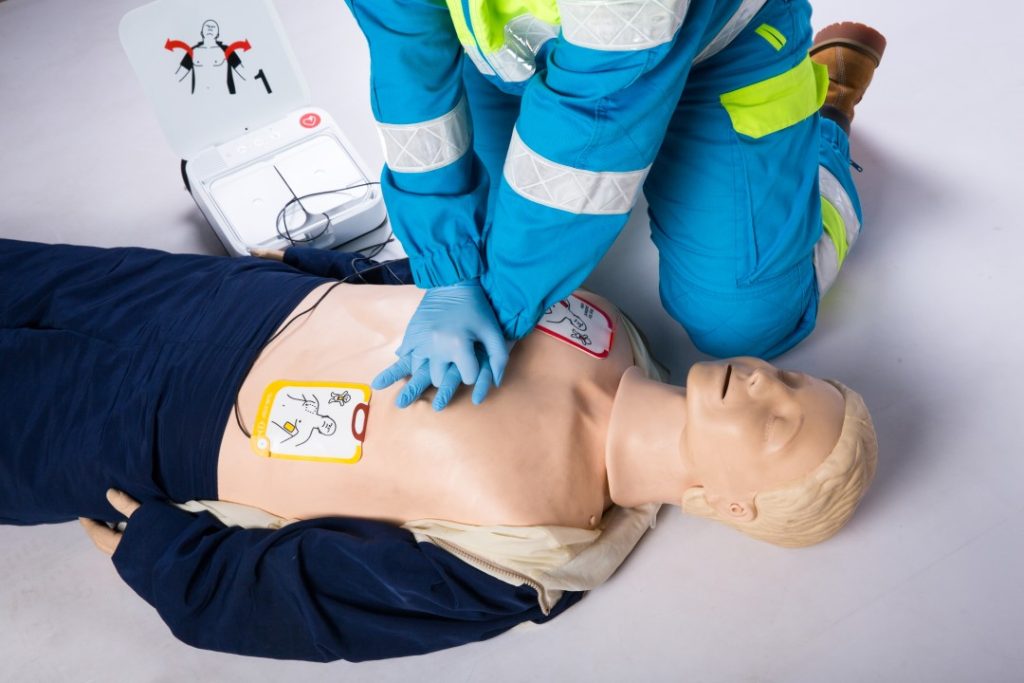Every second counts during cardiac arrest. High-quality chest compression technique can mean the difference between life and death. Yet, many rescuers unknowingly make critical errors that reduce the effectiveness of CPR. Studies show that proper chest compression technique can double or even triple survival rates after cardiac arrest. Understanding how to identify and correct poor compression technique is essential for anyone performing CPR.
Understanding Proper Chest Compression Technique
The American Heart Association establishes clear guidelines for effective chest compression technique. For adults, compressions should reach a depth of at least 2 inches (5 cm) but not exceed 2.4 inches (6 cm). The compression rate should be maintained at 100 to 120 compressions per minute. These specific measurements ensure adequate blood flow to vital organs, particularly the brain and heart.
Research from 2024 confirms that compressions at least 5 cm deep significantly improve survival to hospital discharge compared to compressions less than 4 cm deep. However, excessive depth beyond 6 cm can reduce survival outcomes. This narrow window requires a precise chest compression technique to maximize effectiveness.
Common Signs of Poor Chest Compression Technique
Inadequate Compression Depth
Shallow compressions represent one of the most frequent errors in chest compression technique. Many rescuers fear causing rib fractures and therefore apply insufficient pressure. When compressions fail to reach the recommended 2-inch depth, blood circulation remains inadequate. The heart cannot pump effectively, and oxygen delivery to the brain decreases dramatically.
To identify shallow compressions, observe whether the chest visibly compresses. If the sternum barely moves, the chest compression technique needs adjustment. Remember that proper compressions require significant force, and minor rib injuries are far less concerning than inadequate blood flow.
Incorrect Hand Placement
Proper hand placement forms the foundation of effective chest compression technique. Placing hands too high on the ribs, too low on the abdomen, or off to the side reduces effectiveness and increases injury risk. The heel of one hand should rest on the center of the chest, on the lower half of the sternum between the nipples. The second hand overlaps on top with fingers interlaced.
Poor hand placement often results from positioning yourself incorrectly relative to the patient. Your shoulders should align directly above your hands, allowing you to use your body weight rather than arm strength alone.
Bent Arms During Compressions
A critical yet often overlooked aspect of chest compression technique involves keeping your arms straight. Bending your elbows forces you to rely on arm muscles rather than body weight. This approach causes rapid fatigue and inconsistent compression depth. Research indicates that rescuers who maintain straight arms can perform high-quality compressions for longer periods.
Position yourself on your knees beside the victim with your shoulders directly over the chest. Lock your elbows without hyperextending them, and let gravity assist each compression. This chest compression technique conserves energy and maintains quality throughout the resuscitation effort.
Insufficient Chest Recoil
Complete chest recoil between compressions allows the heart to refill with blood. However, many rescuers lean on the victim’s chest as fatigue sets in. This prevents full recoil and significantly reduces the effectiveness of the chest compression technique. Studies show that incomplete release can decrease blood flow by up to 50%.
Watch for this error by ensuring you lift your weight completely between compressions. The chest should return to its natural position before each subsequent compression. If you notice yourself maintaining constant pressure, adjust your chest compression technique immediately.
Inconsistent Compression Rate
Performing compressions too slowly fails to maintain adequate circulation. Conversely, excessive speed exceeding 120 compressions per minute prevents the heart from refilling between compressions. A meta-analysis examining compression rotation intervals found that maintaining the proper rate becomes increasingly difficult after one minute of continuous compressions.
Studies recommend rotating rescuers every one to two minutes to maintain optimal chest compression technique. The familiar rhythm of “Stayin’ Alive” by the Bee Gees provides an excellent tempo guide at approximately 103 beats per minute.
Excessive Pauses Between Compressions
Interruptions in chest compressions dramatically reduce survival chances. Pauses longer than 10 seconds cause significant drops in coronary and cerebral perfusion pressure. Common causes include switching rescuers, delivering rescue breaths, or checking for pulses. Research shows that minimizing interruptions is associated with improved outcomes.
A 2024 study on prolonged CPR demonstrated that high-quality compressions can be maintained for extended periods when rescuers rotate every minute and use real-time feedback devices. This emphasizes the importance of planning transitions and executing them swiftly.
How to Fix Poor Chest Compression Technique
Position Yourself Correctly
Start by placing the victim on a firm, flat surface. Position yourself beside them on your knees. Your shoulders should align directly above the center of the victim’s chest. This positioning is fundamental to proper chest compression technique because it allows you to use your body weight effectively.
Keep your back straight and avoid leaning to either side. If you find yourself at an awkward angle, reposition before beginning compressions. Proper ergonomics not only improves chest compression technique but also prevents rescuer injury.
Master Proper Hand Placement
Locate the lower half of the sternum by finding the center point between the nipples. Place the heel of one hand firmly on this spot. Position your second hand on top of the first and interlock your fingers. Lift your fingers away from the chest to ensure only the heel of your hand contacts the sternum.
This hand position creates a focused point of pressure that maximizes the effectiveness of the chest compression technique. Practice this placement repeatedly during training to develop muscle memory.
Use Body Weight, Not Arm Strength
Straighten your arms and lock your elbows without hyperextending. Position your shoulders directly over your hands so your body weight drives each compression downward. Push straight down rather than at an angle. This chest compression technique allows gravity to assist you, reducing fatigue and maintaining consistency.
Think of your arms as rigid posts transferring your upper body weight to the chest. This mechanical approach to chest compression technique proves far more sustainable than relying on muscular strength alone.
Ensure Complete Chest Recoil
After each compression, release all pressure and allow the chest to return fully to its normal position. Avoid leaning on the victim between compressions. This complete release phase is as critical to effective chest compression technique as the compression itself.
If you feel fatigued and notice yourself resting your weight on your chest, immediately signal for a rescuer switch. Maintaining proper chest compression technique throughout the resuscitation attempt requires recognition of your physical limitations.
Maintain Consistent Rate and Depth
Count your compressions aloud or use a mental song with the correct tempo. Aim for slightly less than two compressions per second. Focus on achieving the full 2-inch depth with each push. Consistency in both rate and depth characterizes high-quality chest compression technique.
Consider using a metronome app or feedback device during training to internalize the correct rhythm. Real-time audiovisual feedback devices have been shown to improve compression rates, depth, and overall survival rates.
Minimize Interruptions
Plan rescue breath delivery to minimize compression pauses. If performing two-rescuer CPR, coordinate transitions smoothly. Practice switching positions in under five seconds. Advanced planning and clear communication are essential components of effective chest compression technique during prolonged resuscitation efforts.
Research on compression rotation found that switching rescuers every one minute, combined with good communication and feedback devices, maintains high-quality chest compression technique for extended periods. The benefit of 1-minute rotations includes greater compression depth and reduced rescuer fatigue compared to 2-minute intervals.
Training and Feedback for Improved Chest Compression Technique
Modern CPR training emphasizes hands-on practice with feedback devices. These tools provide real-time information about compression depth, rate, and recoil. A 2025 study using smartwatch technology demonstrated that neural network models could accurately predict CPR quality metrics using accelerometer data, showing promise for immediate feedback during actual emergencies.
Regular recertification ensures your chest compression technique remains current with the latest guidelines. The American Heart Association recommends renewal every two years, but practicing more frequently maintains and improves your skills. Training with manikins that provide objective feedback helps identify subtle errors in chest compression technique that might otherwise go unnoticed.
Studies consistently show that compression quality deteriorates over time without regular practice. Healthcare providers and lay rescuers alike benefit from frequent refresher training to maintain proficient chest compression technique.
Special Considerations for Chest Compression Technique
Obesity and Compression Challenges
Patients with obesity require additional force to achieve adequate compression depth due to increased chest wall thickness. A 2024 review examining 34 observational studies found no evidence supporting changes from standard CPR protocols. However, rescuers should anticipate faster fatigue and plan for more frequent rotations when performing the chest compression technique on patients with obesity.
Confined Spaces
The traditional chest compression technique may be impossible in height-restricted environments. Recent research on the “Koch” compression method, using the elbow and forearm as contact points, showed significantly improved compression quality in confined spaces. This modified technique achieved mean quality scores of 66.6% compared to 28.3% for conventional compressions in restricted settings.
Pediatric Considerations
The chest compression technique for children differs from adult protocols. For infants, the two-thumb encircling hands technique (TTHT) provides superior compression depth compared to the two-finger technique. A 2025 study evaluating novel techniques for infant CPR found that proper technique selection significantly impacts both compression efficacy and rescuer endurance in single-rescuer scenarios.
The Impact of High-Quality Chest Compression Technique
The difference between adequate and inadequate chest compression technique directly correlates with survival outcomes. According to the 2024 Cardiac Arrest Registry, only 41.7% of out-of-hospital cardiac arrest victims receive bystander CPR. Among those who do receive bystander intervention, survival to hospital discharge reaches 13.0% compared to just 7.6% for unwitnessed arrests without CPR.
These statistics underscore why mastering proper chest compression technique matters. Every person trained in high-quality CPR represents a potential lifesaver in their community. The skills you develop through proper training and practice could save a family member, friend, or stranger.
Take Action: Master Your Chest Compression Technique Today
Don’t wait until an emergency to discover gaps in your knowledge. Proper chest compression technique requires hands-on training, regular practice, and periodic recertification. The difference between knowing what to do and executing it correctly can save a life.
Ready to master the life-saving chest compression technique? CPR Indianapolis offers comprehensive, stress-free, hands-on training through the American Heart Association. Our expert instructors provide BLS classes in Indianapolis, covering proper chest compression technique for healthcare providers. We also offer ACLS, PALS, and CPR certification courses designed to build your confidence and competence.
Take the first step toward becoming a confident, capable responder. Contact CPR Indianapolis today to enroll in our BLS classes in Indianapolis and gain the skills that could save a life. Visit our training center for initial certification or renewal in all American Heart Association courses. When every second counts, will you be ready?





